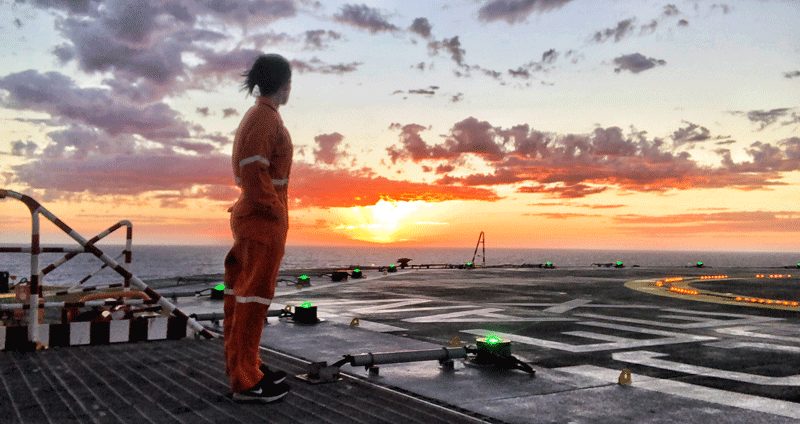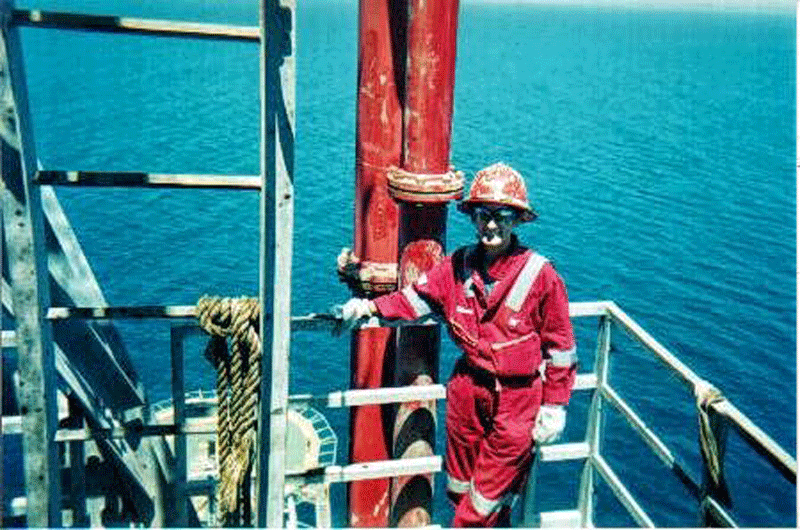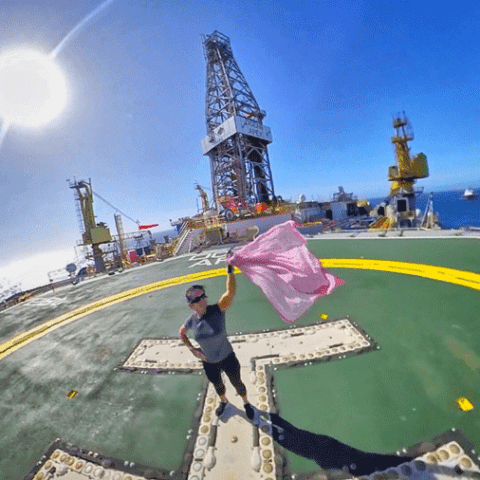Heading Offshore
14:30 hrs – “Fly In” day and we’re about to board the helicopter after undertaking drug and alcohol testing, thorough checks of the belongings in our bags, metal-detecting body scans for contraband items, and viewing the pre-flight safety video. A 4:30 AM check-in at Perth Airport for a 6 AM departure meant a very early rise, followed by a two-hour flight to the closest shore base to the rig, and then the long wait at the heliport. There are a few other flights before us to other rigs in the area, so we patiently await our turn to check in.
With our lifejackets, hearing protection and compressed air breathing apparatus securely fitted, we line up single file and are led to the waiting helicopter, the rotors already screaming to life while the pilots complete their final take-off checks. We are instructed by the ground crew to board three people at a time and are directed to the seat we are to occupy. I’m always relieved if I get a window seat because the window is the primary emergency exit and, if we have to escape in an emergency ditching in the sea and try to get out of the upside down cabin submerged in water, then I won’t have to wait my turn while someone else exits ahead of me. I mentally rehearse the escape procedure we learn in our Helicopter Underwater Escape Training (HUET) training courses, all the while hoping I never have to put it into practice.
 The considerable noise in the cabin and two layers of hearing protection prevent you from being able to carry on a conversation, so everyone sits in silence as the cabin door is slammed shut and we begin to taxi away from the heliport. It doesn’t take long before we are airborne and heading away from the mainland, flying over the turquoise water of the Indian Ocean. I gaze out the window at the magnificent tropical waters. It’s whale migration season and I can see pods of whales breaching and the spray of seawater as they forcefully expel air through their blowhole. It’s wonderful to see these magnificent creatures coexisting with Australia’s energy industry and that strict environmental regulations are placed on the drilling industry to enable this to happen.
The considerable noise in the cabin and two layers of hearing protection prevent you from being able to carry on a conversation, so everyone sits in silence as the cabin door is slammed shut and we begin to taxi away from the heliport. It doesn’t take long before we are airborne and heading away from the mainland, flying over the turquoise water of the Indian Ocean. I gaze out the window at the magnificent tropical waters. It’s whale migration season and I can see pods of whales breaching and the spray of seawater as they forcefully expel air through their blowhole. It’s wonderful to see these magnificent creatures coexisting with Australia’s energy industry and that strict environmental regulations are placed on the drilling industry to enable this to happen.
After an hour of flight time, the pilot announces the start of our descent to the rig. It looks like such a tiny lonely figure off in the distance, surrounded by water as far as the eye can see. It’s time to mentally rehearse the emergency procedures again as landing on the rig is the riskiest part of the journey. I check that my three-point harness is securely fastened and go through the steps in my head for pushing out the emergency window, releasing my harness, pulling myself through the window and swimming to the surface. Thankfully we make a successful landing on the helideck without me having to get wet.
Guided out of the aircraft and off the helideck, the rig helo crew unloads our bags from the cargo hold of the chopper. As we enter the accommodation and helo briefing lounge, the lifejackets and ear defenders are collected from us and given to the outgoing crew, who are already lined up and waiting to depart. We then have a comprehensive briefing by the rig safety officer and rig manager. It’s late afternoon, so I spend the next couple of hours finding my feet and catching up on the operations and the crew I’ll be working alongside. Being on day shift means I can head to my cabin at 6 PM and settle into the room that will be my home for the next four weeks. I’m happy to hit the sack early as I know I’ll have a busy day ahead of me tomorrow . . . and the next 27 days after that!
Day 1 of 28 Begins:
02:30 hrs – iPhone alarm goes off. I selected “Alarm” tone because it’s the loudest. I need to make sure I can hear it through the earplugs I wear to bed, a habit I developed when I first started working offshore on a rust bucket of a rig where I was in a cabin directly over the pump room. Most rigs have a lot of ambient noise, and even PA announcements, so I got used to wearing them all the time to guarantee I got a good quality sleep every night. After thinking about the day ahead of me, I awkwardly climb down the ladder from the top bunk and prepare for my workout in the gym before my shift. As I leave, I pick up the laundry bag on the floor in front of my door, which contains my freshly washed clothes from the day before, and place them in my room.
 03:00 hrs – Gym. Do a 60-minute treadmill or strength training workout, followed by a 30-minute cool down walk on the helideck, while I enjoy the sea breeze and mentally prepare for the drilling operations when I take over from my cross-shift at 6 AM. I can see the drill pipes turning in the derrick, so I know there’s going to be a busy shift of drilling ahead of me.
03:00 hrs – Gym. Do a 60-minute treadmill or strength training workout, followed by a 30-minute cool down walk on the helideck, while I enjoy the sea breeze and mentally prepare for the drilling operations when I take over from my cross-shift at 6 AM. I can see the drill pipes turning in the derrick, so I know there’s going to be a busy shift of drilling ahead of me.
04:30 hrs – Shower and get dressed. I take everything I need for my 12-hour shift. It’s rig etiquette not to go back into your room while your back-to-back is sleeping.
05:00 hrs – Breakfast.
05:30 hrs – Mandatory “pre-tour” meeting before starting our shift. The previous 12-hours of operations are summarized, along with any safety issues, followed by an outline of the expected operations that will be covered on our 12-hour shift.
06:00 hrs – Boots and hard hat on, I walk to the mudlogging (ML) unit where I’ll be spending the next 12 hours. On arrival, I do a handover with my back-to-back who has been working from 6 PM to 6 AM and he fills me in on all the operations that have taken place. During drilling operations (as opposed to running casing operations or cementing operations) there’s always a lot of information to pass on so it can be a lengthy handover. A lot can happen in 12 hours on an offshore rig.
07:00 hrs – Morning report time, which is the time our Daily Geological Report (or DGR) has to be submitted to town. This is a compilation of data collected and observed over the past 24-hour period, from 00:00 hrs to 24:00 hrs each day, plus additional information gathered from the next seven hours up to report time. It’s the on-shift WSG’s job to keep updating this report so, when you end your shift and handover to your back-to-back, the report is up-to-date to your knock-off time. With drilling of the reservoir section underway, it’s going to be busy.
The wellsite geologist is the source of all operational geological information on the rig and is responsible for all geology-related administrative wellsite activity. They are the operator’s eyes and ears on the rig and, as such, have to make sure that all possible geological and drilling information is gathered in a concise and timely manner. While the WSG works in close cooperation with the company man on the rig, they are not actually under his authority. Instead, the WSG reports directly to the operations geologist, who is the “shore based” intermediary between the geologist on the rig and the geology team in town, who will be analysing all the data.
The ML unit is where all the drilling monitoring equipment for the rig is located and also where the mudloggers/sample catchers will deliver the cuttings samples for the WSG to inspect and describe. All rock cuttings are inspected under a microscope and a detailed description written for every sample that’s to be collected in composite 5m intervals. Other duties to be performed in the ML unit (as a joint effort by the WSG and the mudloggers):
- Evaluating correlation with offset well data.
- Analyzing, evaluating and describing formations while drilling, using cuttings, gas and formation evaluation measurement while drilling (FEMWD).
- Advising operations personnel both on the rig and in the onshore operations office about any pertinent geological or drilling information as it arises.
- Identifying any signs of increases in pore pressure by watching for changes in flow rate and active mud system volumes. If the formation pressure becomes higher than the hydrostatic pressure being exerted by the circulating drilling fluid then the mud will become “underbalanced” and the well will “kick.” If this kick isn’t detected early enough then a catastrophic blowout could occur.
- Looking out for presence of “cavings” coming over the shakers. When drilling over-pressured shales, it is common for the formation to undergo stress relief causing chips of rocks to cave from the borehole wall.
- Monitoring for an increase in rate of penetration (ROP) and volume of cuttings. A pressure transition zone will make drilling easier because of the trapped water reducing compaction and the increase in pore pressure reducing differential pressure, allowing cuttings to be released more easily into the mud stream.
- Identifying any changes in LWD data, in particular resistivity and sonic, density and neutron.
- Identifying any changes in drilling parameters, especially torque, drag and overpull. This can be due to deterioration of borehole integrity causing an increase in volume of cuttings and cavings in the circulating mud.
- Observing if there’s any rise in background gas level, changes in the composition of the gas, or presence of “connection” gas, which is a result of swabbing downhole hole when the pumps are turned off to make a connection (add another stand of drillpipe).
- Changes in pump pressure. An influx of gas into a well may reduce the density of the drilling fluid and therefore it will require less pressure to circulate the drilling fluid.
- Change in properties of mud.
- Changes in downhole temperature. Generally, there will be slight decrease in temperature immediately above the over-pressured zone and then a steady increase with depth at a higher rate than in the normally pressured zone above.
08:00 hrs – Morning video call to town operations team. Held in the conference room in the accommodation and attended by company representatives, key business partners and rig personnel. The last 24 hours of rig activities will be discussed and also all daily safety metrics and considerations.
 09:00 hrs – Morning tea time! When we are drilling reservoir or at critical stages of the drilling it’s common to miss this break or grab some take-aways to eat on the run.
09:00 hrs – Morning tea time! When we are drilling reservoir or at critical stages of the drilling it’s common to miss this break or grab some take-aways to eat on the run.
12:00 hrs – Lunch, if you’re lucky enough to have time between sample descriptions or hole problems.
13:00 hrs – “Tech Talk” video conference call with town to discuss the next phase of operations. I mostly need to attend the ones concerning drilling operations and wireline operations. If we are drilling critical zones of the well, I generally can’t leave the ML unit to attend.
15:00 hrs – Afternoon drilling operations update email to the operations geologist, also includes LAS and log file updates from the mudloggers, LWD/MWD engineers and the directional driller, which contain comprehensive drilling and formation evaluation data.
15:15 hrs – Afternoon tea.
17:00 hrs – Ensure all data collection for the shift is up-to-date and the DGR is updated with all pertinent geological information. As there is only one geology workstation, you have to make sure everything is ready to handover when your back-to-back arrives at the start of their shift because you can’t stay and finish.
18:00 hrs – Handover.
18:15 hrs – Go to my cabin, shower, place my dirty work clothes in the laundry bag on the floor outside my cabin for the laundry staff to pick up.
18:30 – Bed. One down, 27 to go . . .
Amanda Barlow is a contract geologist whose 35+ year career includes working within the offshore oil and gas, coal seam gas and minerals industries.
Barlow is also a recreational marathon runner and a published author of three books. She has run 45 marathons in 18 different countries around the world, including the Jungle Marathon in Brazil, which is chronicled in her first published book, Call of the Jungle – How a Camping-Hating City-Slicker Mum Survived an Ultra Endurance Race Through the Amazon Jungle.
Her second book, An Inconvenient Life: My Unconventional Career as a Wellsite Geologist, documents her 35+ year career as a geologist and how she ended up working as a wellsite geologist on offshore oil and gas rigs.
Offshore Oil and Gas PEOPLE: Overview of Offshore Drilling Operations is Barlow’s third book and an overview of what it’s like to work on an oil rig, and the role everyone plays.
She can be contacted through her LinkedIn profile.





